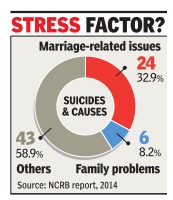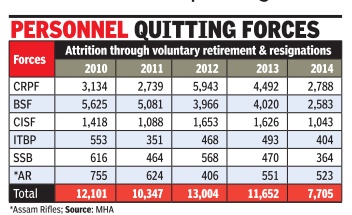Central Para-military Forces (CPMFs): India
This is a collection of articles archived for the excellence of their content. |
2010-14: Attrition rate
Attrition in paramilitary dropped below 10,000
Deeptiman Tiwary The Times of India Mar 06 2015
Slew of Steps For Anti-Red Forces Stops Resignations
Thanks to a host of measures taken by the government to ease pressure on security forces fighting Maoists and positive expectations from the seventh pay commission, lesser number of men in uniform are hanging up their boots. For the first time in the past five years, the cumulative annual attrition from paramilitary forces has dropped below 10,000.
According to latest home ministry data, in 2014, only 7,700 odd personnel quit various central armed police forces as against over 11,000 in 2013 and 13, 000 in 2012.
Sources say the positive change has come about following various measures taken by the government (both UPA and NDA) to ease the hardship of men fighting in Maoist areas and the borders. What has also contributed to the low attrition are expectations of bet ter remuneration from the seventh pay commission next year. It has led to those planning voluntary retirement holding back their decision.
Past few years have seen heavy attrition from forces due to denial of leave, consistent posting in hard areas, poor working conditions, lack of pay parity and separation from family . Between 2009 and 2012, over 44,000 personnel had quit paramilitary forces either through resignations or by opting for volun tary retirement. During the period, more paramilitary men committed suicide (398) than died fighting terrorists (328). The situation had got the government so alarmed that it hired the services of IIM-Ahmedabad to look into the reasons for such a high churn and suggest remedies.
Attrition from CRPF and BSF which face tough working conditions has dropped significantly .
Women personnel and suicides
The Times of India, Jul 23 2015

Atul Thakur & Deeptiman Tiwary
Women account for 2% of central forces, but 40% of suicides
All cases from MP, Telangana, Bihar and J&K
Women constitute less than 2% of central pa ramilitary personnel but account for over 40% of the suicides in these forces, data collated from National Crime Records Bureau and Bureau of Police Research & Development shows. MP , Telangana, Bihar and J&K accounted for all these suicides. The NCRB data on accidental deaths and suicides shows that in 2014, 175 people in central armed police forces including BSF, CRPF, CISF committed suicide. As many as 73 of them or 41.7% were women. Data from BPRD shows that of nearly 9.3 lakh people employed in these forces, just a little over 18,000 were women compared to over 9.1 lakh men.
The data clearly suggests women face a much higher degree of stress. Sources in the forces said they were surprised at the data and said the pattern had not been studied. What that means is that the suicide rate for women in paramilitary forces is 396.9 per lakh compared to just 11.2 per lakh for men. Incidentally , suicide rates for men in paramilitary forces are actually a little lower than in the general population, where it is about 13.9 per lakh. For women, obviously , the rate is way above the rate in the general population, where it is just 7.1 per lakh.
What makes this gender skew even more shocking is that women personnel are not deployed in combat positions.
CRPF has sent its first batch of women personnel for combat roles in Chhattisgarh as a pilot project, but they have not been part of any operation so far. So the reason cannot be stress associated with duty in conflict situations.
The NCRB data suggests that marital discord is the biggest cause of suicides among central paramilitary personnel. Of the total 45 persons suicides due to this reason, who killed themselves because of marriage-related issues 21 were men while 24 women.
Sources from the forces expressed surprise at the data and said there is no study that has examined the high suicide rates among female personnel.They speculated, however, that a major factor could be that it is generally far more difficult for women to work in these forces. Many of them, they pointed out, join the forces in their twenties, which is around the same time as they get married or have children.
